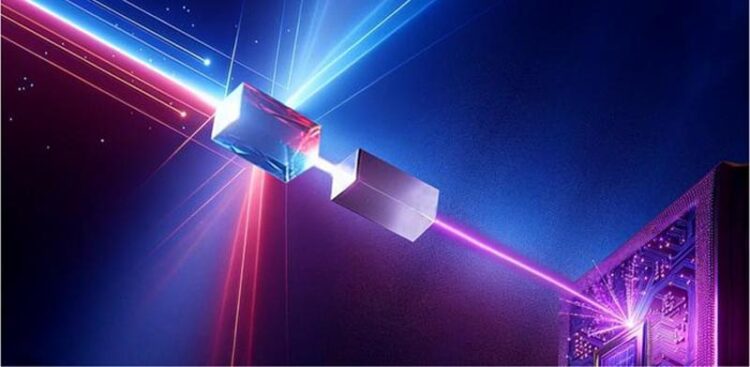Old crystal, new story for enhancing deep ultraviolet laser performance

193-nm DUV laser generated by cascaded LBO crystals.
Credit: H. Xuan (GBA branch of Aerospace Information Research Institute, Chinese Academy of Sciences)
Researchers developed a 60-milliwatt solid-state DUV laser at 193 nm using LBO crystals, setting new benchmarks in efficiency values.
In the realm of science and technology, harnessing coherent light sources in the deep ultraviolet (DUV) region holds immense significance across various applications such as lithography, defect inspection, metrology, and spectroscopy. Traditionally, high-power 193-nanometer (nm) lasers have been pivotal in lithography, forming an integral part of systems used for precise patterning. However, the coherence limitations associated with conventional ArF excimer lasers hinder their effectiveness in applications requiring high-resolution patterns, like interference lithography.
Enter the concept of the “hybrid ArF excimer laser.” Integrating a narrow linewidth solid-state 193-nm laser seed in place of the ArF oscillator achieves enhanced coherence alongside narrow linewidth, thus enabling improved performance in high-throughput interference lithography. This innovation not only boosts pattern precision but also accelerates lithography speed.
Moreover, the hybrid ArF excimer laser’s heightened photon energy and coherence facilitate direct processing of various materials, including carbon compounds and solids, with minimal thermal impact. This versatility underscores its potential in diverse fields, from lithography to laser machining.
To optimize seeding for an ArF amplifier, the linewidth of the 193-nm seed laser must be meticulously controlled, ideally below 4 gigahertz (GHz). This specification dictates the coherence length crucial for interference, a criterion readily met through solid-state laser technologies.
A recent breakthrough from researchers at the Chinese Academy of Sciences propels this field forward. As reported in Advanced Photonics Nexus, they achieved a remarkable 60-milliwatt (mW) solid-state DUV laser at 193 nm with a narrow linewidth using a sophisticated two-stage sum frequency generation process employing LBO crystals. The process involves pump lasers at 258 and 1553 nm, derived from a Yb-hybrid laser and an Er-doped fiber laser, respectively. This setup, culminating in a 2mm×2mm×30mm Yb:YAG bulk crystal for power scaling, demonstrates impressive results.
The generated DUV laser, accompanied by its 221-nm counterpart, exhibits an average power of 60 mW, a pulse duration of 4.6 nanoseconds (ns), and a repetition rate of 6 kilohertz (kHz), with a linewidth of approximately 640 megahertz (MHz). Notably, this marks the highest power output for both 193- and 221-nm lasers generated by an LBO crystal, along with the narrowest linewidth reported for a 193-nm laser.
Of particular note is the outstanding conversion efficiency achieved: 27 percent for 221 to 193 nm and 3 percent for 258 to 193 nm, setting new benchmarks in efficiency values. This research underscores the immense potential of LBO crystals in generating DUV lasers at power levels ranging from hundreds of milliwatts to watts, opening up avenues for exploring other DUV laser wavelengths.
According to Prof. Hongwen Xuan, corresponding author for the work, the reported research demonstrates “the viability of pumping LBO with solid-state lasers for reliable and effective generation of narrow-linewidth laser at 193 nm, and opens a new way to fabricate a cost-effective, high-power DUV laser system using LBO.”
These advancements not only push the boundaries of DUV laser technology but also hold promise for revolutionizing myriad applications across scientific and industrial domains.
For details, see the original Gold Open Access article by Z. Zhang et al., “High-power, narrow linewidth solid-state deep ultraviolet laser generation at 193 nm by frequency mixing in LBO crystals,” Adv. Photon. Nexus 3(2) 026012 (2024), doi 10.1117/1.APN.3.2.026012
Journal: Advanced Photonics Nexus
DOI: 10.1117/1.APN.3.2.026012
Method of Research: Experimental study
Subject of Research: Not applicable
Article Title: Old crystal, new story for enhancing deep ultraviolet laser performance
Article Publication Date: 1-Apr-2024
Media Contact
Karen Thomas
SPIE–International Society for Optics and Photonics
karent@spie.org
Office: 360-685-5492
All latest news from the category: Physics and Astronomy
This area deals with the fundamental laws and building blocks of nature and how they interact, the properties and the behavior of matter, and research into space and time and their structures.
innovations-report provides in-depth reports and articles on subjects such as astrophysics, laser technologies, nuclear, quantum, particle and solid-state physics, nanotechnologies, planetary research and findings (Mars, Venus) and developments related to the Hubble Telescope.
Newest articles

NASA: Mystery of life’s handedness deepens
The mystery of why life uses molecules with specific orientations has deepened with a NASA-funded discovery that RNA — a key molecule thought to have potentially held the instructions for…

What are the effects of historic lithium mining on water quality?
Study reveals low levels of common contaminants but high levels of other elements in waters associated with an abandoned lithium mine. Lithium ore and mining waste from a historic lithium…

Quantum-inspired design boosts efficiency of heat-to-electricity conversion
Rice engineers take unconventional route to improving thermophotovoltaic systems. Researchers at Rice University have found a new way to improve a key element of thermophotovoltaic (TPV) systems, which convert heat…



